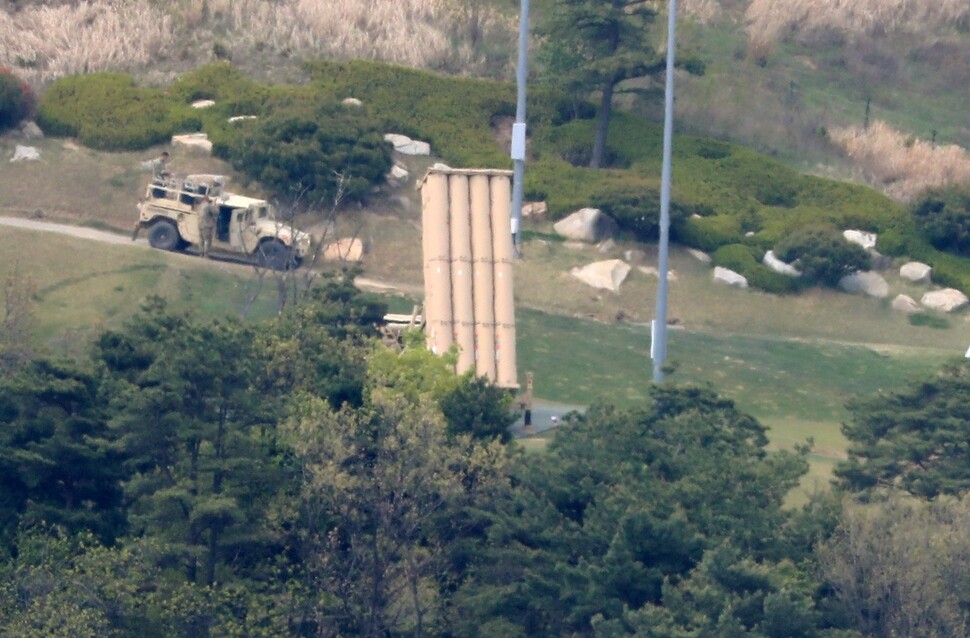hankyoreh
Links to other country sites 다른 나라 사이트 링크
[Editorial] The South Korean gov’t’s responsibility for $1 billion THAAD bill

US President Donald Trump came out for two straight days on Apr. 28 and 29 demanding that South Korea pay US$1 billion in costs for deployment of a THAAD system with US Forces Korea. Trump paid no mind to the existing agreement between the two sides, which has the US covering costs for THAAD’s deployment and maintenance while South Korea provides the site and infrastructure. Blue House Office of National Security chief Kim Kwan-jin said on Apr. 30 that he had confirmed the agreement on the US shouldering THAAD costs in a telephone conversation with White House National Security Advisor H. R. McMaster.
For now, the South Korean government seems to be breathing a sigh of relief. But the public isn’t resting easy. By way of explaining Trump’s remarks, McMaster said they were “made in a general context in line with the U.S. public expectations on burden-sharing with allies.” This sounds as though the same thing could happen again in the future, depending on how the US political situation unfolds.
The Washington Post called this the “madman theory.” The idea is to gain the upper hand in future negotiations by terrifying the other side into thinking you’re crazy. The US is now in a position where it can use Trump‘s remarks to lean strongly on South Korea in next year’s talks on the sharing of defense costs. It’s not at all unlikely that costs for THAAD’s deployment and operation are going to end up falling on Seoul anyway through an increased defense cost share. The costs of ever more frequent and larger-scale joint military exercises, the mobilization of US strategic weapons like the aircraft carrier USS Carl Vinson, and the purchase price of US-made weapons are also things the US is pressing for more money on.
At a National Assembly Steering Committee plenary session last July, Kim fielded a question from Justice Party lawmaker Roh Hoe-chan on whether there was a chance THAAD deployment costs could be included in South Korea‘s share of defense expenses. Kim’s answer at the time was that they “could be if the item is included” - so the current situation wasn’t completely unanticipated. The surprise rush to ignore procedure and deploy THAAD ahead of its originally scheduled date at year’s end appears to bear some connection to Kim’s two visits to the US this past January and March, where he pushed hard for an early deployment. Did Seoul’s rush to deploy THAAD as soon as possible give Trump a pretext to demand money? Kim’s demands for an early deployment also came just after the National Assembly vote to impeach then-President Park Geun-hye, which raises questions about whether this was part of an attempt to sway public opinion on the impeachment by playing up security issues.
The South Korean government announced the THAAD deployment out of the blue on July 8 of last year as a “presidential decision.” That president has since been impeached, and Kim himself leaves office a week from now. All that will remain is the THAAD system deployed ambush-style in Seongju, North Gyeongsang Province and a bill for US$1 billion from Trump. Who should take responsibility? And what exactly happened, anyway? We need to get to the bottom of whether Kim orchestrated the early THAAD deployment on his own, or whether he was acting on directions from Park while she was technically suspended from her presidential duties. A National Assembly hearing should be held if necessary. Only when we know the truth can the proper measures be taken.
Please direct questions or comments to [english@hani.co.kr]

Editorial・opinion
![[Column] Park Geun-hye déjà vu in Yoon Suk-yeol [Column] Park Geun-hye déjà vu in Yoon Suk-yeol](https://flexible.img.hani.co.kr/flexible/normal/500/300/imgdb/original/2024/0424/651713945113788.jpg) [Column] Park Geun-hye déjà vu in Yoon Suk-yeol
[Column] Park Geun-hye déjà vu in Yoon Suk-yeol![[Editorial] New weight of N. Korea’s nuclear threats makes dialogue all the more urgent [Editorial] New weight of N. Korea’s nuclear threats makes dialogue all the more urgent](https://flexible.img.hani.co.kr/flexible/normal/500/300/imgdb/original/2024/0424/7317139454662664.jpg) [Editorial] New weight of N. Korea’s nuclear threats makes dialogue all the more urgent
[Editorial] New weight of N. Korea’s nuclear threats makes dialogue all the more urgent- [Guest essay] The real reason Korea’s new right wants to dub Rhee a founding father
- [Column] ‘Choson’: Is it time we start referring to N. Korea in its own terms?
- [Editorial] Japan’s rewriting of history with Korea has gone too far
- [Column] The president’s questionable capacity for dialogue
- [Column] Are chaebol firms just pizza pies for families to divvy up as they please?
- [Column] Has Korea, too, crossed the Rubicon on China?
- [Correspondent’s column] In Japan’s alliance with US, echoes of its past alliances with UK
- [Editorial] Does Yoon think the Korean public is wrong?
Most viewed articles
- 1‘We must say no’: Seoul defense chief on Korean, USFK involvement in hypothetical Taiwan crisis
- 2N. Korean delegation’s trip to Iran shows how Pyongyang is leveraging ties with Moscow
- 346% of cases of violence against women in Korea perpetrated by intimate partner, study finds
- 4Amnesty notes ‘erosion’ of freedom of expression in Korea in annual human rights report
- 5‘Weddingflation’ breaks the bank for Korean couples-to-be
- 6[Column] Park Geun-hye déjà vu in Yoon Suk-yeol
- 7Will NewJeans end up collateral damage in internal feud at K-pop juggernaut Hybe?
- 8Korea sees more deaths than births for 52nd consecutive month in February
- 9“Parental care contracts” increasingly common in South Korea
- 10[Interview] Dear Korean men, It’s OK to admit you’re not always strong